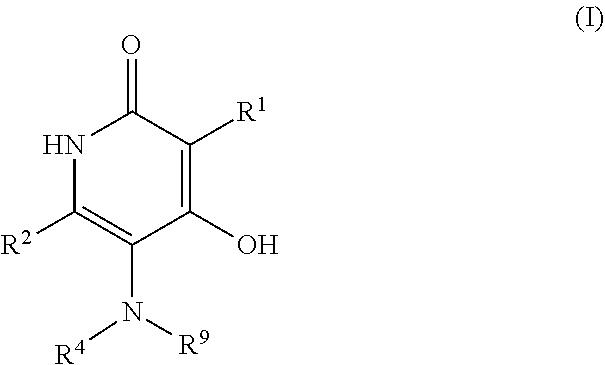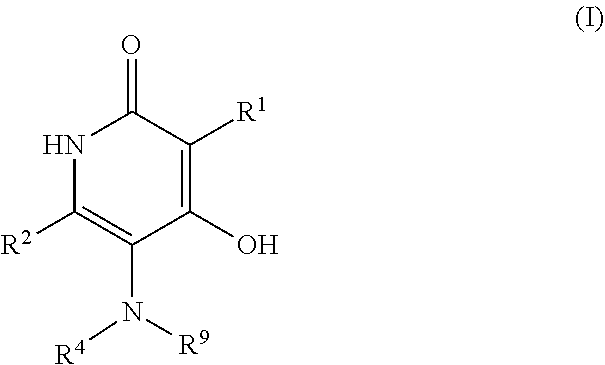3-sulfonyl-5-aminopyridine-2,4-diol apj agonists
a technology of apj and aminopyridine, which is applied in the field of 3sulfonyl-5aminopyridine2, 4diol compounds, can solve the problems of poor prognosis, impaired quality of life, and only 50% survival ra
- Summary
- Abstract
- Description
- Claims
- Application Information
AI Technical Summary
Benefits of technology
Problems solved by technology
Method used
Image
Examples
example 001a
o-3-oxoheptanoate
[0509]Sodium ethoxide (10.8 ml, 29.0 mmol) was dissolved in EtOH (58.1 ml). Ethyl 3-oxoheptanoate (5.15 ml, 29.0 mmol) was added followed by dropwise addition of bromine (1.50 ml, 29.0 mmol). After 1 hour, the reaction was diluted with water and extracted twice with DCM. The combined organic layers were washed with brine, dried with sodium sulfate, filtered, and concentrated in vacuo. The residue was purified by column chromatography (ISCO, 80 g silica gel column, 29 minute gradient from 0 to 30% EtOAc in hexanes) to yield Example 001A (6.56 g, 26.1 mmol, 90%) as a clear oil. LC / MS (Method A) RT=0.96 min, MS (ESI) m / z: 251.0 (M+H)+. 1H NMR (400 MHz, CHLOROFORM-d) δ 4.78 (s, 1H), 4.28 (q, J=7.1 Hz, 2H), 2.75 (td, J=7.3, 3.4 Hz, 2H), 1.65-1.53 (m, 3H), 1.31 (t, J=7.0 Hz, 3H), 0.98-0.86 (m, 4H).
example 001b
(ethyl(phenyl)amino)-3-hydroxyhept-2-enoate
[0510]Example 001A (1.35 g, 5.37 mmol) and N-ethylaniline (0.650 g, 5.37 mmol) were dissolved in EtOH (10.73 ml) and heated to reflux for 14 h. The reaction mixture was concentrated in vacuo. The residue was dissolved in EtOAc, washed with water, washed with brine, dried with sodium sulfate, filtered, and concentrated in vacuo. The residue was purified by column chromatography (ISCO, 80 g silica gel column, 29 minute gradient from 0 to 100% DCM in hexanes) to yield Example 001B (0.876 g, 3.01 mmol, 56.0%) LC / MS (Method A) RT=1.23 min, MS (ESI) m / z: 292.3(M+H)+. 1H NMR (400 MHz, CHLOROFORM-d) δ 12.60 (s, 1H), 7.22-7.15 (m, 2H), 6.73-6.67 (m, 1H), 6.63 (dd, J=8.8, 0.9 Hz, 2H), 4.25-4.12 (m, 2H), 351-3.32 (m, 2H), 2.37-2.21 (m, 2H), 1.28-1.24 (m, 2H), 1.19 (t, J=7.2 Hz, 3H), 1.12 (t, J=7.2 Hz, 3H), 0.98-0.89 (m, 2H), 0.84 (t, J=7.3 Hz, 3H)
example 001c
amino-2-(ethyl(phenyl)amino)hept-2-enoate
[0511]Example 001B (0.943 g, 3.24 mmol) and ammonium acetate (2.50 g, 32.4 mmol) were dissolved in MeOH (16.18 ml). The reaction mixture was allowed to stir at 50° C. for 14 h. The reaction mixture was concentrated under reduced pressure and the residue was dissolved in EtOAc and water. The layers were separated and the organic layer was washed with brine, dried with sodium sulfate, and concentrated under reduced pressure. The residue was purified by column chromatography (ISCO, dry load, 80 g silica gel column, 29 minute gradient from 0 to 100% EtOAc in hexanes) to yield Example 001C (0.552 g, 1.90 mmol, 58.7% yield) as a pale yellow oil. LC / MS (Method A) RT=1.068 min, MS (ESI) m / z: 291.2 (M+H)+. 1H NMR (400 MHz, CHLOROFORM-d) δ 7.20-7.06 (m, 2H), 6.79-6.49 (m, 3H), 4.28-3.90 (m, 2H), 3.59-3.23 (m, 2H), 2.32-2.18 (m, 2H), 1.50-1.38 (m, 2H), 1.36-1.22 (m, 4H), 1.22-1.15 (m, 3H), 1.11-1.05 (m, 3H), 0.87-0.81 (m, 3H).
PUM
| Property | Measurement | Unit |
|---|---|---|
| Fraction | aaaaa | aaaaa |
| Composition | aaaaa | aaaaa |
Abstract
Description
Claims
Application Information
 Login to View More
Login to View More - R&D
- Intellectual Property
- Life Sciences
- Materials
- Tech Scout
- Unparalleled Data Quality
- Higher Quality Content
- 60% Fewer Hallucinations
Browse by: Latest US Patents, China's latest patents, Technical Efficacy Thesaurus, Application Domain, Technology Topic, Popular Technical Reports.
© 2025 PatSnap. All rights reserved.Legal|Privacy policy|Modern Slavery Act Transparency Statement|Sitemap|About US| Contact US: help@patsnap.com



